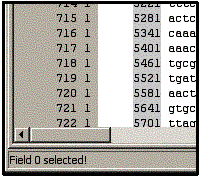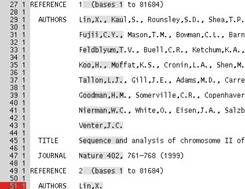|
Input Data Panel

The Input Data Panel toolbar consists of 4 tools:
Open : As you would expect this tool opens a data file. Examples of data files that might be used in Vect include files from GenBank, Kegg, or any number of other sources. It also allows you to work on multiple files at once, displaying them sequentially in the panel in the order in which they are opened.
Close : This tool closes a data file. If multiple files have been opened in the panel, Vect will give you a choice of which file to close.
Clear : This tool clears all rules that you have developed to this point (explained later in this tutorial.) Note that this tool does not close your data files, which must be done by the Close tool.
Move : This tool extracts the data defined by the Data-dependent rules (explained in next section), and transfers this data to the Convert Data panel. The Convert Data panel is automatically opened for you at this point, but you can return to the Input Data panel at any time by clicking on the Input Data tab.
The main task performed in the Input Data Panel is the extraction of data from files by developing Data-dependent rules through the use of the following six methods:
1. Field Selection
Vect organizes the data into fields based on word orientation from the left most column. A left click on the field will select it.
If a word is selected that represents the third field of a line (i.e. the third word on the line), then all words and numbers located in the third field of each line will be selected and will be shown by a grey highlighted region. The region can be deselected by again clicking on the grey highlighted region. Note that the regions that are highlighted in gray are the data regions that will be extracted from the document for further processing in the Convert Data Panel.
2. Field-Column Selection
A field-column is a portion of a field. To specify a field column, left-click and drag over the region desired within a single field.
For example, if you select the 3 rd, 4 th and 5 th letter of the 3 rd field of a line, then the 3 rd, 4 th and 5 th letter of the 3 rd field of every line will be selected. You will notice that for some data files this will mean that the gray areas of the “column” will skip in a zigzag fashion. (see image on the right).
If you select a region that extends past the beginning or end of a field then you will no longer be selecting a field column. This will give you a line column, which is described in the next section.
3. Line-Column Selection
A line-column is similar to a field column, but its boundaries are relative to the beginning of the line and not to the beginning of a particular field. This creates what we intuitively think of as a column, capturing all data in a straight vertical region. It can be selected with a left-click and drag just like the field column selection but must extend beyond the boundaries of a single field. It may in fact include several fields. If you wish to select a line column that falls within the boundaries of a single field, then you must use as ‘Forced’ line column as described next.
 
|